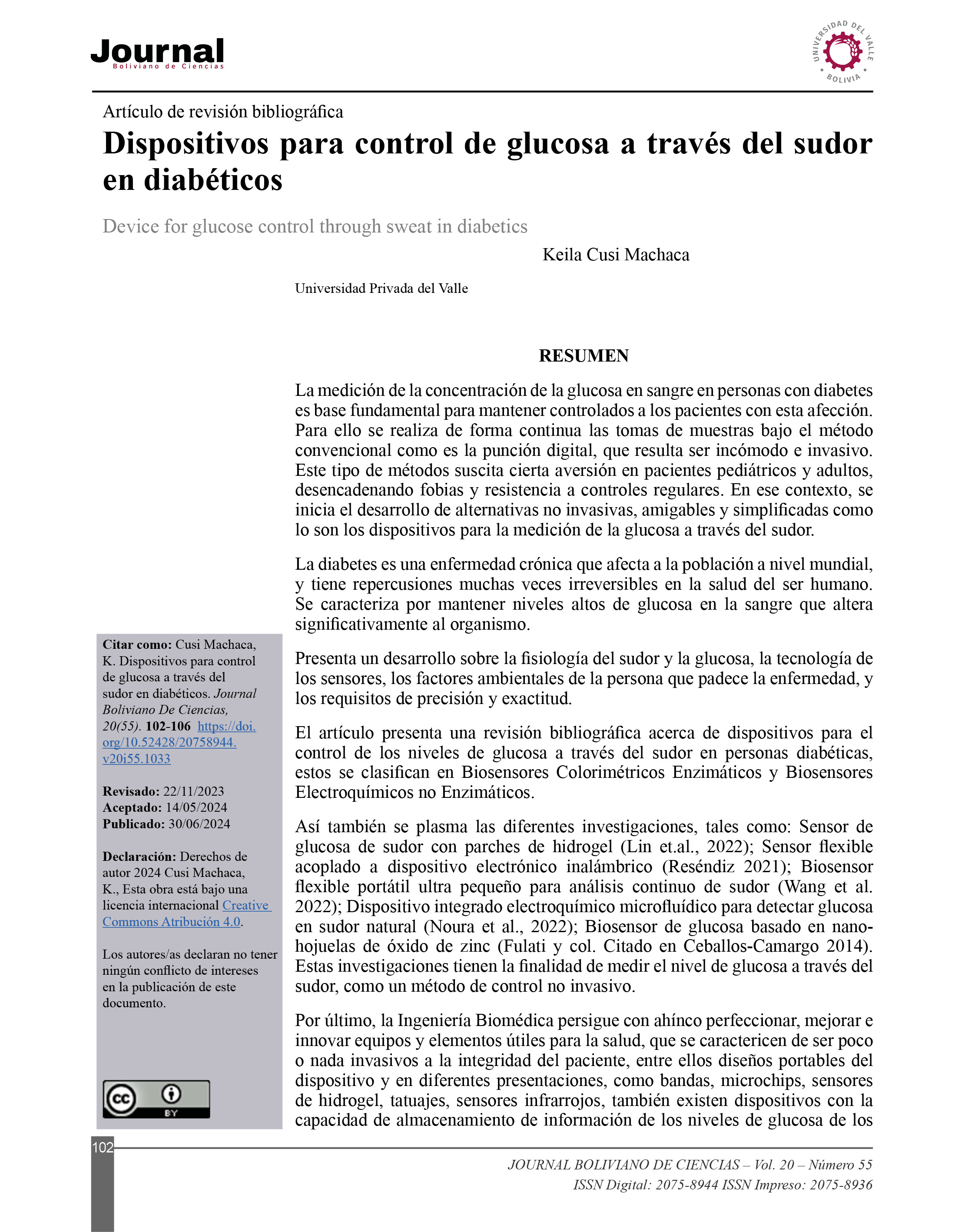Device for glucose control through sweat in diabetics
DOI:
https://doi.org/10.52428/20758944.v20i55.1033Keywords:
Biomedicina, Biosensor, Diabetes, Glucosa, SudorAbstract
The measurement of blood glucose concentration in people with diabetes is a fundamental basis for keeping patients with this condition under control. To do this, samples are continuously taken using the conventional method such as finger puncture, which is uncomfortable and invasive. This type of method arouses a certain aversion in pediatric and adult patients, triggering phobias and resistance to regular controls. In this context, the development of non-invasive, friendly and simplified alternatives such as devices for measuring glucose through sweat begins. Diabetes is a chronic disease that affects the population worldwide, and often has irreversible repercussions on human health. It is characterized by maintaining high levels of glucose in the blood that significantly alters the body. It presents a development on the physiology of sweat and glucose, sensor technology, the environmental factors of the person suffering from the disease, and the requirements for precision and accuracy.
Downloads
References
American Diabetes Association. (2021). Classification and Diagnosis of Diabetes: Standards of Medical Care in Diabetes-2021. Diabetes Care, 44(1). https://doi.org/10.2337/dc21-S002 DOI: https://doi.org/10.2337/dc21-Srev
https://doi.org/10.2337/dc21-S002 DOI: https://doi.org/10.2337/dc21-S002
PMid:33298413
Ceballos-Camargo, L., Narro, R., Sandoval, J. (2014) Biosensores electroquímicos de glucosa. CienciaCierta.10 (39). http://www.cienciacierta.uadec.mx/2014/09/06/biosensores-electroquimicos-de-glucosa/
Financiación e Investigación SACSIS. (2020, 3 de Junio). Los niveles TRLs en el sector de dispositivos médicos. https://financiacioneinvestigacion.com/blog/niveles-trls-dispositivos-medicos/
Karpova, E., Shcherbacheva, E., Galuchin, A., Vokhmyanina, D., Karyakina, E., Karyakin, A. (2019) Monitoreo no invasivo de la diabetes a través del análisis continuo del sudor utilizando un biosensor de glucosa de flujo continuo. Analylical Chemestry. Chemistry Faculty. 6 (91) 3778-3783. Russia. Recuperado de https://pubs.acs.org/doi/10.1021/acs.analchem.8b05928
https://doi.org/10.1021/acs.analchem.8b05928
PMid:30773009
https://doi.org/10.1021/acs.analchem.8b05928
https://doi.org/10.1021/acs.analchem.8b05928 DOI: https://doi.org/10.1021/acs.analchem.8b05928
PMid:30773009
Khor, S. M., Choi, J., Won, P., & Ko, S. H. (2022). Challenges and Strategies in Developing an Enzymatic Wearable Sweat Glucose Biosensor as a Practical Point-Of-Care Monitoring Tool for Type II Diabetes. Nanomaterials (Basel, Switzerland), 12(2), 221. https://doi.org/10.3390/nano12020221
https://doi.org/10.3390/nano12020221
PMid:35055239 PMCid:PMC8781831
https://doi.org/10.3390/nano12020221
https://doi.org/10.3390/nano12020221 DOI: https://doi.org/10.3390/nano12020221
PMid:35055239 PMCid:PMC8781831
Hernández, D., & Hernández, J. (2023). Dianetes, Inteligencia Artificial e Internet de las cosas médicas: nuevas tendencias en la medicina. Komputer Sapiens, 1, 41-64.
Lin, P., Sheu, S., Chen, C., Huang, S., & Li, B. (2022). Wearablehydrogel patch with noninvasive, electrochemical glucose sensor for natural sweat detection. Talanta, 241(1), 123187. https://doi.org/https://doi.org/10.1016/j.talanta.2021.123187
https://doi.org/10.1016/j.talanta.2021.123187
PMid:35030501
https://doi.org/10.1016/j.talanta.2021.123187
https://doi.org/10.1016/j.talanta.2021.123187 DOI: https://doi.org/10.1016/j.talanta.2021.123187
PMid:35030501
Liu, Q., Liu, Y., Wu, F., Cao, x., Li, Z., Alharbi, M., Abbas, A.N., Amer, M.R. & Zhou Ch. (2018) Altamente sensible y portátil In2O3 Biosensores de transistores de nanoribbono con puerta integrada en el chip para el monitoreo de glucosa en fluidos corporales. ACS Nano, 12 (2) 1170-1178. https://doi.org/10.1021/acsnano.7b06823
https://doi.org/10.1021/acsnano.7b06823
PMid:29338249
https://doi.org/10.1021/acsnano.7b06823
https://doi.org/10.1021/acsnano.7b06823 DOI: https://doi.org/10.1021/acsnano.7b06823
PMid:29338249
Loaiza-Martinez, M. D. L. (2019). Diseño del proyecto para construir un dispositivo no invasivo de control de glucosa (Master's thesis). Recuperado de https://reunir.unir.net/handle/123456789/8165
Noura, Z., Shah, I., Aziz, S., Ahmed, A., Jung, D., Brahim, L., & Elmostafa, R. (19 de Noviembre de 2022). Wereable Healthcare Monitoring Based on a Microfluidic Electrochemical Integrated for Sensing Glucose in Natural Sweat. Sensors (Basel), 22(22), 8971. https://www.mdpi.com/1424-8220/22/22/8971
https://doi.org/10.3390/s22228971
PMid:36433566 PMCid:PMC9698867
https://doi.org/10.3390/s22228971
https://doi.org/10.3390/s22228971 DOI: https://doi.org/10.3390/s22228971
PMid:36433566 PMCid:PMC9698867
Organización Mundial de la Salud (2019). Diabetes. Recuperado de: https://www.who.int/es/news-room/fact-sheets/detail/diabetes
Organizanizacion Panamericana de Salud. (27 de abril de 2012). Diabetes. Organizacion Panamericana de Salud: https://www3.paho.org/hq/index.php?option=com_content&view=category&id=4475&layout=blog&Itemid=40610&lang=es&limitstart=15
Padash M, Enz C, Carrara S. Microfluidics by Additive Manufacturing for Wearable Biosensors: A Review. Sensors (Basel). 2020 Jul 29;20(15):4236. doi: 10.3390/s20154236. PMID: 32751404; PMCID: PMC7435802.
https://doi.org/10.3390/s20154236
PMid:32751404 PMCid:PMC7435802
https://doi.org/10.3390/s20154236
https://doi.org/10.3390/s20154236 DOI: https://doi.org/10.3390/s20154236
PMid:32751404 PMCid:PMC7435802
Pérez, D., & Orozco , J. (2022). Wearable electrochemical biosensors to measure biomakers with complex blood-to-sweat partition such as proteins and hormones. Microchim Acta , 189(127). https://doi.org/https://doi.org/10.1007/s00604-022-05228-2
https://doi.org/10.1007/s00604-022-05228-2
PMid:35233646 PMCid:PMC8886869
https://doi.org/10.1007/s00604-022-05228-2
https://doi.org/10.1007/s00604-022-05228-2 DOI: https://doi.org/10.1007/s00604-022-05228-2
PMid:35233646 PMCid:PMC8886869
Ramírez-Domínguez, S.E., Estrada-López, J.J., López-Huerta, F. (2022). Métodos no invasivos de detección de glucosa para el tratamiento y diagnóstico de diabetes. Revista Internacional de Investigación e Innovación Tecnológica. 10 (57) 65-76. https://riiit.com.mx/apps/site/files_v2450/glucosa_ver._5_div_jul-ago_2022_v1.pdf
Reséndiz, A. (2021). Desarrollo de un sensor inalámbrico flexible para la cuantificación de glucosa en sudor (Tesis de pregrado). Universidad Autónoma de Querétaro. Querétaro. https://ri-ng.uaq.mx/bitstream/123456789/3541/1/IGLIN-257406-1121-622-Ariadna%20Yaneli%20Resendiz%20Jaramillo%20%20%20-A.pdf
Reyes, P. Blanchard, G., Arredondo, T., Galindo, C., Glaría, A., Roncagliolo, P., Aguirre, L., Jara, A. (2011). Sistema móvil de monitoreo no invasivo y de gestión de enfermedades crónicas para pacientes afectados de diabetes. Proyecto de Investigación no publicado. Universidad de Valparaiso, Chile. Recuperado de https://www.conicyt.cl/wp-content/themes/fondef/encuentra_proyectos/PROYECTO/06/I/D06I1094.html
Rigalleau,V., Monlun,M., Foussard, N., Blanco,L., Mohammedi K. (2021) Diagnóstico de Diabetes. EMC-Tratado de medicina, 25 (2) 1-7. Recuperado de https://doi.org/10.1016/S1636-5410(21)45110-X
https://doi.org/10.1016/S1636-5410(21)45110-X
https://doi.org/10.1016/S1636-5410(21)45110-X
https://doi.org/10.1016/S1636-5410(21)45110-X DOI: https://doi.org/10.1016/S1636-5410(21)45110-X
Samaniego Bañuelos, F. (2019). ¿De qué diabetes estamos hablando?.. Editorial ITACA. https://elibro.net/es/lc/bibliounivalle/titulos/120365
Silos Chincoya, G. ., Martínez Oliva, G. G. ., & Chairez Oria, J. I. (2021). Dispositivo de Monitoreo de Glucosa en Sangre No Invasivo mediante Infrarrojo Cercano. Memorias Del Congreso Nacional De Ingeniería Biomédica, 8(1), 173-177. Recuperado a partir de https://memoriascnib.mx/index.php/memorias/article/view/890
Wang, J., Wang, L., Li, G., Yan, D., Liu, C., Xu, T., & Zhang, X. (2022). Ultra-Small Wearable Flexible Biosensor for Continuous Swear Analysis. ACS Sens, 10(3), 3102-3107. https://doi.org/10.1021/acssensors.2c01533. Epub 2022 Oct 11. PMID: 36218347.
https://doi.org/10.1021/acssensors.2c01533
PMid:36218347
https://doi.org/10.1021/acssensors.2c01533
https://doi.org/10.1021/acssensors.2c01533 DOI: https://doi.org/10.1021/acssensors.2c01533
PMid:36218347

Published
How to Cite
Issue
Section
License
Copyright (c) 2024 Keila Cusi Machaca

This work is licensed under a Creative Commons Attribution 4.0 International License.
Authors who publish with this journal agree to the following terms:
- Authors retain copyright and grant the journal right of first publication with the work simultaneously licensed under a Creative Commons Attribution License 4.0 that allows others to share the work with an acknowledgement of the work's authorship and initial publication in this journal.
- Authors are able to enter into separate, additional contractual arrangements for the non-exclusive distribution of the journal's published version of the work (e.g., post it to an institutional repository or publish it in a book), with an acknowledgement of its initial publication in this journal.
- Authors are permitted and encouraged to post their work online (e.g., in institutional repositories or on their website) prior to and during the submission process, as it can lead to productive exchanges, as well as earlier and greater citation of published work.














